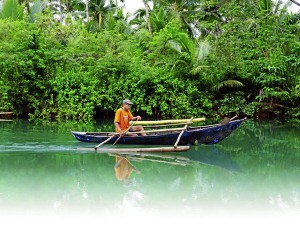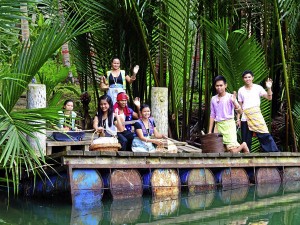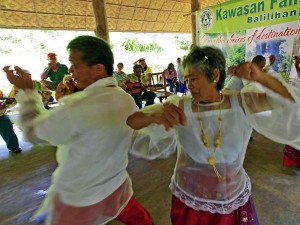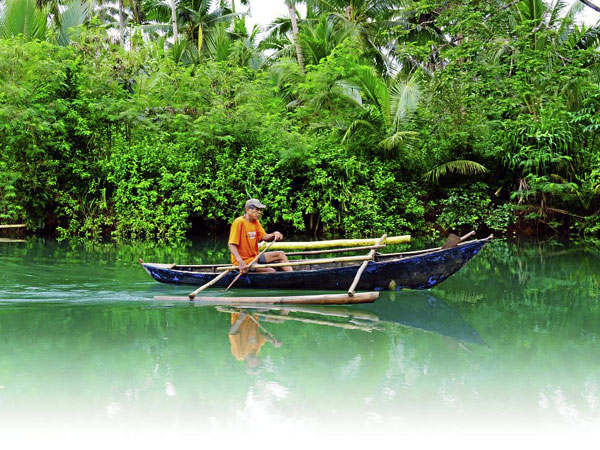
(If you enjoyed the Loboc River cruise, you’d welcome the Abatan River Community tour, which takes a closer look at Bohol’s more rustic river towns and their age-old traditions)
The most unexplored places often yield a wealth of discoveries and treasures. And tourists who take a cruise down a river in Bohol don’t need to be archaeologists or even art connoisseurs to marvel at, or even just appreciate, the consolidated efforts of local communities to showcase their culture.
In this case, the initiative is even more noteworthy as it reflects actual townsfolk in their real world – people at the grassroots level – taking pride in, and doing everything it takes to preserve and display, true Filipino culture.
The Abatan River Community Tour takes the visitor on a scenic, entertaining and educational tour down five municipalities of the province – Antequera, Balilihan, Catigbian, Cortes, and Maribojoc. Each of the towns has a cultural dance and theater group that presents a production number at each stop.
The program, organized by the Process-Bohol Inc., is in coordination with the Department of Tourism and the provincial government of Bohol. According to Emilia Roslinda, Process-Bohol executive director, the training of the production groups is conducted with the support of and in consultation with the National Commission for Culture and the Arts. The tour is also part of Bonamine’s “Basta Pinas” campaign, which encourages domestic tourists to discover the unexplored tourist spots that are equally exciting and heart-pounding as other already popularized sites. Aside from adventure and the usual sight-seeing, this tourism project hopes to tackle history, culture, and tradition.

The 13.5-kilometer river cruise begins at the Abatan River Development Management Council (ARDMC) in the municipality of Cortes, about 15 minutes from the capital, Tagbilaran City. A brief orientation kicks off the tour, explaining the background of the project and what the cruise participants may expect.
The Abatan River itself is rich in history and legends, says Roslinda, as it was the center of trade and commerce centuries ago. “Abat actually means to meet or to converge,” she added.
The second stop is at the Lincod Satellite Village Center in Maribojoc town, where visitors are greeted by the sound of tingko, a native musical instrument said to have been used in the early times to signal the arrival of guests.
The Lincod Cultural Collective gives an interpretative dance number which narrates the simple way of life of the locals, whose main source of livelihood is nipa-weaving and fishing.
As the bandong (boat) continues on the cruise, visitors are greeted by the sight of lush mangroves and nipa plants. It takes around 20 to 30 minutes to get to the next stop of Antequera town where guests are treated to a performance by the Antequera Cultural Collective that includes a serenade and a showcase of the Antequeraños main livelihood—basket-weaving and bamboo furniture making. A short exhibition and hands-on demonstration follows, and guests are encouraged to try their hand at weaving.
A souvenir shop at the second floor of the village center entices guests to sample the town’s handicraft products – pouches, bracelets, baskets and household décor –that make for simple keepsakes or pasalubong (homecoming gifts).

Another rather long stretch takes guests to the fourth and last stop: the town of Balilihan, where a group of kids playing the flute greets them. A medley of musical numbers follows from the Kawasan Rondalla composed mainly of senior members of the community. The elderly also execute a dance number showing the courtship tradition in the town. And it couldn’t get any more romantic with the Kawasan Falls, a two-layered falls with a 50-meter drop, in the background.
Across the grounds are women engaged in the chores and routine that mark regular Balilihan life – rice threshing using a mortar and pestle, and the traditional stone-grinding of malagkit (sticky rice).
While these activities may look commonplace to Filipinos, foreign guests can take a peek into the culture that is slowly seeing its twilight years. Also notable in the tour is the opportunity given the elderly to relive their age-old traditions and pass them on to the younger generation. It is refreshing as well to see older men and women performing with gusto.
Roslinda said that it took years before the Abatan River Community Life Tour was fully operational and implemented. She clarified that this river cruise is not intended to rival the already famous Loboc River tour, but instead “complement it.”
To preserve the serenity of the Abatan River and the towns along it, Roslinda said that the ARDMC masterplan has guidelines that investors and other tourism agencies should follow. The fusion of arts and culture and ecotourism may look like an odd blend, but it works for the Abatan River Community Life Tour. More attractions are upcoming, Roslinda says, that are meant to complement the already established tours of Bohol. •
For more about the river cruise visit: www.processbohol.org









































